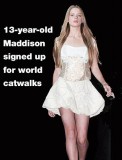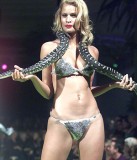May you save this picture on your local computer? Should that picture be considered potentially dangerous? At least, you must be aware of the terms, definitions and legal consequences before judging the sites you come across.
Definitions:
- child pornography – means any visual depiction, including any photograph, film, video, picture, or computer-generated image or picture, whether made or produced by electronic, mechanical, or other means, of sexually explicit conduct, where:
- the production of such visual depiction involves the use of a minor engaging in sexually explicit conduct;
- such visual depiction is a digital image, computer image, or computer-generated image that is, or is indistinguishable from, that of a minor engaging in sexually explicit conduct; or
- such visual depiction has been created, adapted, or modified to appear that an identifiable minor is engaging in sexually explicit conduct.
- minor – means any person under the age of eighteen years
- identifiable minor –
- means a person—
- who was a minor at the time the visual depiction was created, adapted, or modified; or
- whose image as a minor was used in creating, adapting, or modifying the visual depiction; and
- who is recognizable as an actual person by the person’s face, likeness, or other distinguishing characteristic, such as a unique birthmark or other recognizable feature; and
- shall not be construed to require proof of the actual identity of the identifiable minor.
- means a person—
- sexually explicit conduct – means actual or simulated:
- sexual intercourse, including genital-genital, oral-genital, anal-genital, or oral-anal, whether between persons of the same or opposite sex;
- bestiality;
- masturbation;
- sadistic or masochistic abuse;
- lascivious exhibition (also graphic or simulated) of the genitals or pubic area of any person;
- graphic – when used with respect to a depiction of sexually explicit conduct, means that a viewer can observe any part of the genitals or pubic area of any depicted person or animal during any part of the time that the sexually explicit conduct is being depicted; and
- indistinguishable – used with respect to a depiction, means virtually indistinguishable, in that the depiction is such that an ordinary person viewing the depiction would conclude that the depiction is of an actual minor engaged in sexually explicit conduct. This definition does not apply to depictions that are drawings, cartoons, sculptures, or paintings depicting minors or adults.
- illegal pose – In a 1986 case called U.S. v. Dost, a federal judge suggested a six-step method to evaluate the legality of images. Here’s an excerpt from the opinion:
- Whether the focal point of the visual depiction is on the child’s genitalia or pubic area.
- Whether the setting of the visual depiction is sexually suggestive.
- Whether the child is depicted in an unnatural pose, or in inappropriate attire, considering the age of the child.
- Whether the child is fully or partially clothed, or nude.
- Whether the visual depiction suggests sexual coyness or a willingness to engage in sexual activity.
- Whether the visual depiction is intended or designed to elicit a sexual response in the viewer.
Now, some examples.
In a federal indictment announced this week, the U.S. Department of Justice accused Pierson, 43, of being a child pornographer–even though even prosecutors acknowledge there’s no evidence he has ever taken a single photograph of an unclothed minor.
Rather, they argue, his models struck poses that were illegally provocative. “The images charged are not legitimate child modelling, but rather lascivious poses one would expect to see in an adult magazine,” Alice Martin, U.S. attorney for the northern district of Alabama, said in a statement.
Because no sex or nudity is involved, the prosecutions raise unusual First Amendment concerns that stretch beyond mere modelling-related Web sites: children and teens in various degrees of undress appear in everything from newspaper underwear advertisements to the covers of Seventeen and Vogue.
When actress and model Brooke Shields was 15 years old, for instance, she appeared in a racy Calvin Klein jeans advertisement featuring the memorable line, “Nothing comes between me and my Calvins.” Shields also appeared nude at 12 years old in an Oscar-nominated movie called Pretty Baby that was set in a New Orleans brothel. Similarly, 14-year-old Jodie Foster, wearing revealing clothing, played a pre-teen prostitute in Martin Scorsese’s Taxi Driver.
Sally Mann, named Time magazine’s “photographer of the year” in 2001, was attacked by critics for featuring nude images of her own children in a book called Immediate Family. Famed photographer Jock Sturges’ photos often feature nude boys and girls on the beaches of California and France–images that are far more revealing than those of swimsuit-clad youths.
All of that makes the distinction between legal child photography and illegal child pornography a particularly subjective one. It may come down to […] seemingly ephemeral factors such as the poses the model strikes and the camera angles the photographer chooses.
The U.S. Congress tried to clear up some of the ambiguity around what is and what isn’t legal but never actually enacted legislation.
In 2002, Rep. Mark Foley announced a bill called the Child Modeling Exploitation Prevention Act that would effectively ban the sale of photographs of minors.
Five legal scholars contacted by Wired News said that Foley’s proposal, cosponsored by Rep. Nick Lampson (D-Texas) and touted at a press conference on Monday, is so broadly written that it would imperil perfectly innocent photography and videography of children and teenagers.
In addition to prohibiting commercial photography of anyone under 17 years old, their bill would make it a federal felony for stock photo houses like Corbis or Getty Images to license images of minors from their catalogs — a billion-dollar industry — or for news photographers to sell images of minors.
James Mitchell, associate general counsel for Corbis, said the Child Modelling Exploitation Prevention Act, or CMEPA, would “negatively impact the industry” and likely violates the First Amendment’s guarantees of freedom of speech.
“The Corbis collection includes commercial and editorial images that could potentially fall within the language of the bill as currently written,” Mitchell said. “These images are far from inappropriate, but rather, are lawfully and appropriately licensed by business clients all over the world.”
Corbis owns approximately 65 million images, including the Bettman Archive and historic photos of Rosa Parks, the Kennedys, the Beatles and Marilyn Monroe.
Eric Freedman, who teaches First Amendment law at Hofstra University, said CMEPA would ban prints of the haunting 1972 image of a girl covered by napalm. It was taken by Associated Press photographer Huyn Cong (Nick) Ut, won a Pulitzer Prize and helped to turn U.S. sentiment against the Vietnam war.
As a result, the CMEPA never left committee.
That leaves judges and juries faced with the difficult task of making distinctions between lawful and unlawful camera angles and facial expressions–an exercise that proves to be impossible to do without running afoul of the First Amendment.
“How do we distinguish pictures like these (on child modelling sites) from the everyday photos that our culture tolerates and even prizes?” said Adler, the NYU law professor. “For instance, who’s modeling in Vogue? A lot of those people are 15 and in scantily clad or suggestive photos.”
Six British ISPs are filtering access to Wikipedia after the site was added to an Internet Watch Foundation child-pornography blacklist, according to Wikipedia administrators.
As of Sunday, December 07, morning UK time, certain British web surfers were unable to view at least one Wikipedia article tagged with ostensible child porn. And, in a roundabout way, the filtering has resulted in Wikipedia admins banning large swaths of the United Kingdom from editing the “free encyclopedia anyone can edit”.
On Friday, Wikipedia administrators noticed that Virgin Media, Be Unlimited/O2/Telefonica, EasyNet/UK Online, PlusNet, Demon, and Opal were routing Wikipedia traffic through a small number of transparent proxy servers as a way of blocking access to the encyclopedia’s article on Virgin Killer, a mid-1970s record album from German heavy metal band the Scorpions.
However, as of Sunday evening UK time, the offending image is still freely available on Amazon, and as the controversy over Wikipedia rolls on, it is being reproduced on hundreds of sites available in the UK and across the world.
Naturally, Virgin Killer is now among the most popular pages on the English-language version of Wikipedia.
The IWF has also posted a statement on its website. It reads, in part:
A Wikipedia web page was reported through the IWF’s online reporting mechanism in December 2008. As with all child sexual abuse reports received by our Hotline analysts, the image was assessed according to the UK Sentencing Guidelines Council (page 109). The content was considered to be a potentially illegal indecent image of a child under the age of 18, but hosted outside the UK. The IWF does not issue takedown notices to ISPs or hosting companies outside the UK, but we did advise one of our partner Hotlines abroad and our law enforcement partner agency of our assessment. The specific URL (individual webpage) was then added to the list provided to ISPs and other companies in the online sector to protect their customers from inadvertent exposure to a potentially illegal indecent image of a child.
All the above begs the question: “Now what?” OK, let’s see here…
- the following image (took me quite a while to find a good example 😉 might be considered sexually explicit (questionable items 4.3, 4.5) though not a child porn because of item 6 (it’s a drawing or a cartoon!)

- the only concern (though extremely questionable) what may be raised about the following photo is 7.3 – inappropriate attire:

- And finally, the following official photos of 12yo (13yo on one photo) fashion model and the Face of Gold Coast Fashion Week Maddison Gabriel can be considered as a child porn because of all subitems of item 7:




References:
- U.S. Code collection. TITLE 18 > PART I > CHAPTER 110 > § 2256
- Federal case may redefine child porn – CNET News
- On the Web, nearly nude child porn tests laws – Herald Tribune
- Too Broad a Ban on Child Models? – Wired
- Brit ISPs censor Wikipedia over ‘child porn’ album cover – The Register
- “Virgin Killer” by Scorpions – Wikipedia
- “Nevermind” by Nirvana – Wikipedia
- Blind Faith by Blind Faith – Wikipedia
- world-fashion-show.html”>Fury as 12-year-old ‘model’ fronts world fashion show – Dailymail
- Ron Clarke backs child model Maddison Gabriel – Geelong Advertiser
- Little Girls in a Sick Society – Fox News
- Is 12 too young to be a model? – BBC
- 13-year-old Maddison Gabriel is the kitten of the catwalk – Daly News
- Fashion Week chooses 12-year-old model – Gold Coast
- Child model’s mum slams critics – Gold Coast
- Madison Gabriel – the price of innocence – Brit and Grit
- 12-летняя австралийка Мэдисон Габриэль оказалась в центре громкого скандала – ORT






pretty tame if you ask us.really its just a skirt.
Yeah, the skirt could have been smaller in size 😉
have you seen the russian and eastern european sites? Anything here is tame compared to there,comments??
“rubberdaddy ” wrote:
have you seen the russian and eastern european sites?
Hm… apparently not …